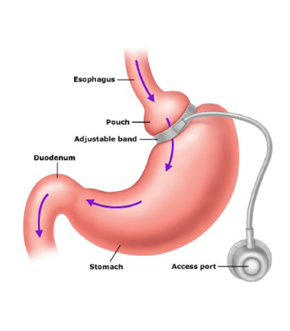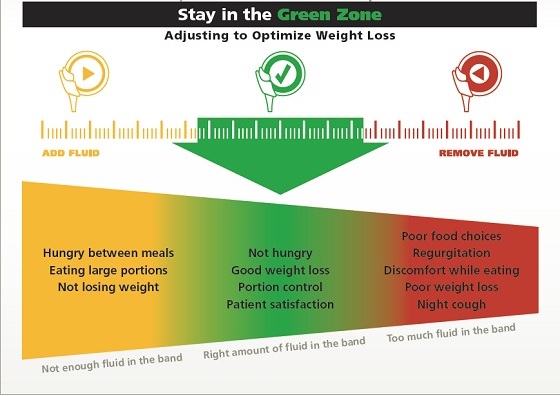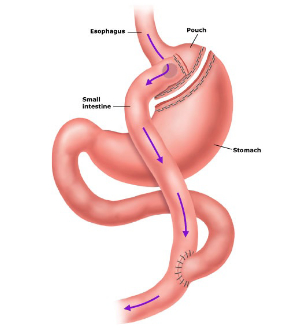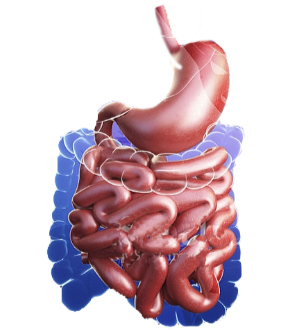
The Lap-Band® is a very safe, effective, and reversible surgical tool to assist patients with weight loss and maintenance of their weight loss. Lap-Band surgery is done laparoscopically. The properly adjusted band reduces physical hunger and provides satiety with small meals
Description of Procedure. The Lap-Band is placed through 3 or 4 small laparoscopic incisions on the abdomen. The Lap-Band is an adjustable silicone band that is placed around the upper part of the stomach. It creates a small, proximal stomach pouch, with the larger part of the stomach below the Lap-Band.
The Lap-Band controls the opening between the two parts of the stomach. The upper part fills when solid food is eaten and this causes you to feel full with a smaller portion of food. There are receptors in the wall of the upper stomach. The Lap-Band sends a signal to the appetite center of the brain, known as the hypothalamus, via the vagus nerve. The ingested food empties into the lower stomach at a controlled rate. This creates a feeling of fullness after a very small amount of food is eaten and helps you feel full longer.
The Lap-Band is connected to a port that lies under the skin and fat of the abdominal wall by a thin tube. It is unlikely that you will be able to feel the port until there has been significant weight loss. Saline is injected into the port or removed from the port to vary the size of the band around the stomach. This is called an “adjustment” or “fill.” When your Lap-Band is adjusted, it changes the opening between the small stomach pouch on the top and the remaining stomach below the Lap-Band.
Benefits of The Lap-Band Procedure
- An adjustable silicone band is placed around the upper portion of the stomach
- A small portion is created above the band
- A small pouch means smaller food portions
- Lap band can be tightened to help slow food passage to the lower stomach
- Laparoscopic procedure
- 30-minute average surgical time
- Low surgical risk percentages of 0.30%
- Same day discharge after surgery
- Return to a non-physical strenuous job in 6 days
- 1 to 2 pound weight loss per week (Based on following Tri State Bariatrics dietary and exercise guidelines)
- 45% of excess weight loss in first year

Adjustments, to your lap-band, are based on the Green Zone theory.
Lap-Band adjustments are performed in all five of our office locations and are primarily done by our Nurse Practitioners using ultrasound localization and local anesthesia to provide quick and painless adjustments.
Green Zone
When the Lap-Band is optimally adjusted, the patient feels satisfied after eating small meals and experiences prolonged satiety after these meals. Patients are losing 1-2 pounds a week or are able to maintain weight loss after goal weight has been reached. There is a range outside the Green Zone where the band may be too tight or too loose.
Yellow Zone
If the Lap-Band is too loose, the patient will feel hungry and small meals do not satisfy. Saline needs to be added to the Lap-Band.
Red Zone
If the Lap-Band is too tight, the patient will have difficulty swallowing. Night coughing, reflux and regurgitation may occur. The patient may choose foods that pass more easily despite being high in calories. Saline needs to be removed from the Lap-Band.
The Lap-Band requires strict adherence to a specific dietary regimen and mastery of proper eating techniques.


